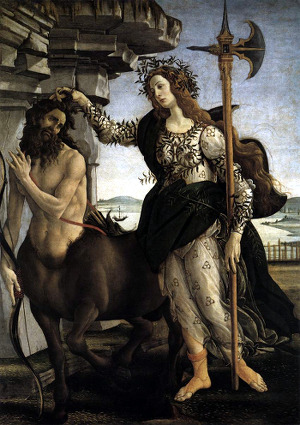Innovation and Tradition: an Inseparable Pair
The study of human psychology has shown us that there cannot be any harmonious development of personality (the individual, as a group) if there isn’t a “secure basis” (mother, family, a culture, a tradition etc.,) that allows the individual to explore himself, the others and the world. Where there is no such secure basis, the individual is in a state of anxiety and he makes use of defensive maneuvers and resistance in order to minimize the distress for the separation from a support (John Bowlby, “Attachment and Loss” 1969).
 In a time like this, where the constant development of technology tends to merely “solve” any daily problem, a sense of deep uncertainty grows more and more in man, basically derived from the constant inhibition of its imaginative activities .
In a time like this, where the constant development of technology tends to merely “solve” any daily problem, a sense of deep uncertainty grows more and more in man, basically derived from the constant inhibition of its imaginative activities .
Our intuitive (and imaginative) capability makes us adept at solving even unexpected and unpredictable situations. Today, however, the technological tools are created to eliminate the unexpected, the danger, the irrationality, to make sure that everything is as predictable, controllable and manageable as possible.
Today’s world seems committed to build machines that are able to offer safety, prediction, analysis and control. Television gives us visual experiences that we passively absorb in a sort of bulimia, while it decreases our attention, concentration and critical skills. In other words, in its mainly technological development, modern society gives us the illusion of power by providing tools that eliminate the need to use the full potential of human intelligence, such as our ability to imagine new unexplored possibilities.
It would seem that the complex capacity of the human being is becoming irrelevant to his survival in the world, since the technology seems to offer better securities.
However, the loss of the enchantment of the world, the charm of the ‘mysterious and wonderful thing’ that is life, is extensively perceived. We feel a general dissatisfaction and the growing need to rediscover the creativity and the innovative spirit.
In the article “We need creativity: which one?” we tried to outline the main aspects related to the meaning of this need and today we want to analyze a method of approach to innovation that can hide pitfalls and failures.
It may seem a paradox, yet often very creative ideas and innovations are rejected even when they represent a desired goal. This prejudice is born when the proposed innovation does not base its origin on a solid secure basis, as defined by John Bowlby. This effect has been studied and shown a few years ago in a Cornell University research: there is a hidden deception in the proposition of creative ideas that can generate a strong resistance in their acceptance.
However, the more novel an idea, the more uncertainty can exist about whether an idea is practical, useful, error free, and reliably reproduced. After conducting a series of experiments among the population, the study therefore comes, among other things, to these conclusions:
- Creative ideas are by definition novel, and novelty can trigger feelings of uncertainty that make most people uncomfortable.
- People dismiss creative ideas in favor of ideas that are purely practical — tried and true.
- Objective evidence shoring up the validity of a creative proposal does not motivate people to accept it.
- Anti-creativity bias is so subtle that people are unaware of it, which can interfere with their ability to recognize a creative idea.
There are many reasons that can lead to these feelings, but what is not evaluated in the report of Cornell University is the composition of the creative idea submitted for examination to the group, its origin and its specific construction. A really creative action, in fact, must always be necessarily included in an original model. Only in this way, it will not produce anxiety because the creative actor joins himself – through his action – to the rhythm of the world (G. Lampis – Noia, Ansia e Creatività).

History often tells us of insights and innovative ideas that have changed the world, but almost always they were born from an amazing ability to look at reality and recognize what was already in embryo in the cultural tradition, waiting to be unearthed, discovered. Paulo Coelho is referring to this in his novel “The Alchemist“, reworking of a famous parable of Rabbi. At the end of a long and troubled path, the main character discovers that the treasure that he had seen in his dream and that he had painstakingly searched, was always hidden in his garden: “Those who don’t understand their Personal Legends will fail to comprehend its teachings”.
Pope Francis himself, who as a result of his policies of church government is widely considered an innovator, has created a universal consensus and given reliability and solidity to his action for change also beginning with the choice of the name of a Saint whose tradition is rooted in the whole world.
The need to innovate by creating a bridge with the traditional cultural base has also been observed in the field of business management. Many names have been coined for this method of approach to the problem, including The Medici Effect and Humanistic Management. Unanimous is the need to look forward gluing together the split derived from a too rapid development of techno-science, which has now engulfed other countless resources for the harmonious development of society, distracting the man from his own creative imagination.
However, we still want to reiterate that creativity does not mean to destroy the world that exists to create a new one. This would mean creating a wasteland, a material and moral desert, no more rules, models, landmarks, coordinates. And from here the anxiety, rather the anguish generated by the void: nihilism and boredom. A refined and detailed description of this phenomenon is offered by Fyodor Dostoyevsky in his novel ” Demons“. “The revolutionaries forcedly end up by having the same tares of the society that they would like to transform” (Irving Howe – Politics and the Novel – 1962).
Then, the innovator is not a destroyer that presents something new built on a base with no reference to the known world: this action generates anxiety because of the uncertainty of the result and the loss of a secure basis. The Great Innovator is always the one who knows how to find in creation and in its laws the way that other men can no longer see, “that something” that seems lost and of which, however, a strong need is felt. From here, the charm and success of novels and detective fiction (the search for truth), of adventures to discover hidden treasures, movies or books that recall ancient Myths in modern dresses, etc.
We would like to end up by saying that novelties – even and especially those that may seem revolutionary – must always engage in the fertile ground of an ancient and consolidated tradition, in order to draw and build a reliable way to the future.

